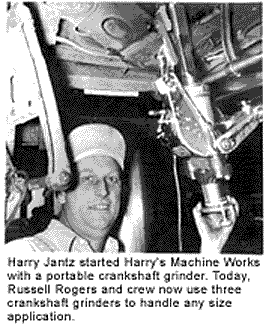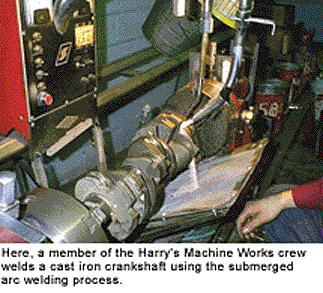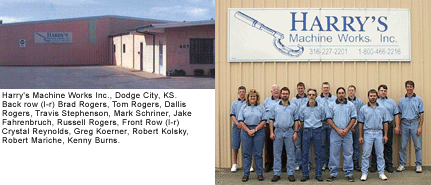No history of the American West would be complete without extensive recollections of Dodge City, KS. Formed as a convenient railroad stop to serve the new Atchison, Topeka and Santa Fe railroad, Dodge City offered something for everyone.
That is, if your tastes ran to buffalo hunting, gambling or gunfighting. In its early days, Dodge City had it all. With its tough reputation and even tougher lawmen – Bat Masterson, Bill Tilghman, Charlie Bassett and Wyatt Earp – Dodge City embodied the pioneering spirit of the Old West.
Likewise, Engine Builder magazine’s 2002 Machine Shop of the Year has its long and storied history as well. Harry’s Machine Works of Dodge City has served the machine shop and engine rebuilding needs of its Kansas customers for more than five decades. The sheriff in town, Russell Rogers, says the shop’s number one priority is the same as those legendary lawmen – protect the innocent.
"I know it sounds hokey and a lot of people say it, but my first goal is to do a quality job," says Rogers. "There are times when we do our best just to look out for a customer who just doesn’t know better. We spend a LOT of time on customer education."
Rogers and his staff are careful to explain the need for proper machining techniques to each customer. Although the majority of his service is for local garages, Harry’s Machine Works also serves a growing Hispanic community. "We don’t have anyone on staff who speaks Spanish fluently and it can be a real challenge, especially if there are really complicated repairs needed," says Rogers. "We’ll get an interpreter if we need to because we don’t want to feed their skepticism that we’re just out to make a quick buck off of them. Unfortunately, we see a large number of DIYers trying to work on their own late model cars with early model experience."

With his shop location in Kansas, Rogers says the biggest demand, naturally, is agricultural-related. "We see many different heavy duty diesel engines used to power the tractors, combines, swathers and other equipment, as well as many sizes of engines used for natural gas-powered irrigation units," says Rogers. "Motors we handle range from small six-cylinder passenger engines to very large Caterpillars (G342 and G353) and everything in between.
Still, Rogers says Harry’s is expected to keep up with the latest domestic and import automotive machining services including cylinder head rebuilding and all necessary block, rod and crank reconditioning techniques.
To be able to handle this variety of machine work efficiently, Harry’s Machine Works has a large amount of equipment. For crankshaft repair work, Rogers says his operation has three crankshaft grinders for handling small to very large cranks. "Most of the time we’ll use a combination of the machines, one for rods and one for mains," he says.
Additional equipment found in the crankshaft department includes a wet magnetic particle inspection machine capable of handling shafts up to 100 inches long, a crank press, hardness tester, shot blasting cabinet (for stress relieving the radius after grinding), balancing equipment a crankshaft welder, and a new oven to heat materials up to 1,000 degrees F.
For cylinder head rebuilding, cores are checked for integrity with the wet magnetic particle inspection system as well as with the Newclear pressure tester. To surface heads, three milling machines (a Storm Vulcan 85b, a Scledum RT7P and a Robbi 1550 boring mill) are available. Seat and guide work and finish three-angle cutting is handled on a Sunnen VGS20, and valves are ground on a Kwik-Way valve refacer.
"We pay close attention to the installed stem height and head recession or protrusion," says Rogers. "New seats are installed when necessary. We do not grind the tips of valves or mill unnecessary amounts of material to correct these problems."

After block core integrity is confirmed, each engine block is checked for alignment, including correct main cap fit. Housing bore tolerances must meet book specifications, says Rogers, and alignment is checked with a precision bar. If align boring is determined to be needed, loose caps are built up using molybdenum wire applied through the Metco 12e metallizing equipment.
"The caps are ground and torqued and the alignment can be corrected with an align hone. If align bore is needed, we’ll use either the Berco BC4 or BC5, depending on the size of the block," Rogers explains. "After the align bore has been repaired, we rebore the cylinders on our Rottler F2B, leaving three- to four-thousandths for the finish hone. We’ll use the Sunnen CV616 and follow the plateau honing procedure to accomplish the correct size and finish." Diesel blocks are checked for accurate counterbore recession as well as for cracks in the counterbore landing. If any are found, they are sleeved. Similarly, the O-ring area is inspected for cavitation and sleeved where necessary.
Next, says Rogers, the deck surface is milled and counterbores cut with the shop’s Mira counterbore tool. All upper and lower block work is done on the Robbi 1550 boring mill. "Set up is done by locating on the main saddles to ensure parallelism," explains Rogers. "Then, after finish-machining, the centerline to deck height is measured. Adjustments are made as needed to either rod length or piston compression distance to attain the specified piston protrusions."
The rod shop at Harry’s Machine Works consists of two rod hones, one power stroke and one manual, one piston pin press and rod heater and a pin boring machine, all Sunnen products. Housing bore tolerance is held to .0003? round, taper, bellmouth or barrelmouth.
For general machine work, Harry’s has three engine lathes, with the largest capable of handling a 27-inch swing and an 80-inch bed. To add to the special machine work capabilities, a Bridgeport mill and a large radial arm drill press are available as well.
"Just to diversify even more, we repair many ‘non engine-related" parts too," explains Rogers. "We sleeve bearing housings in transmissions, reclaim worn threads and key areas, rebuild worn bushings and much more."
One type of repair process that Harry’s specializes in is the metallizing procedure. As mentioned, Rogers’ crew uses the Metco wire flame spray process to build up caps using molybdenum or chrome type stainless steel wire. "This process is also excellent for rebuilding seal areas or worn areas on shafts that use press fit bearings and small engine crank pins," Rogers says. "The thing that makes metallizing so nice is that it bonds well but does not transfer a lot of heat to the parent material. Less heat means the process does not cause crystallization and finish grinding can be done shortly after buildup."
Rogers says his shop does only custom engine rebuilds and very seldom two of the same. "For that reason, we rely heavily on AERA’s PROSIS software to give us the most accurate information available to build the best engine possible," he says.
Each engine built by Harry’s has a one-year/10,000-mile/1,000-hour warranty (whichever is appropriate). "For component machine work, if an error is found during assembly, we make the necessary corrections, reimburse for travel expenses, replace any parts ruined and provide necessary labor due to our mistake," Rogers says.

Employees Are A ‘Cut Above’
Rogers feels the most important reason his shop earned Machine Shop of the Year honors is because of the commitment to a total team effort. "We really feel that we have graciously been provided with the equipment and the God-given talent to serve customers in need," Rogers says. "Each machinist feels a strong desire to improve the quality of his designated task so the customer can have the best possible product with the shortest amount of ‘downtime.’ "
Education has played a huge part in the shop’s success. Harry’s Machine Works boasts three ASE-certified "Master Machinists:" Russell Rogers, Kenny Burns and Travis Stephenson. Greg Koerner is cylinder head and block certified, Robert Kolsky is cylinder head certified and Robert Mariche is block certified. All full-time employees have their high school diplomas, and office manager Crystal Reynolds holds a Bachelors degree in business.
"Most machinist’s education has come from apprentice on-the-job training or through courses at Dodge City Community College," says Rogers. "We train our employees in-house as often as possible. For those with little or no experience, the first step is tear down and inspection. From there, they’ll move on to machining as they show the desire and ability to handle the precise measuring necessary to meet our stringent standards."
For Harry’s, those standards are exceptionally tight, but the variety of equipment makes meeting them realistic. "It is easier to hold the tighter tolerances we impose upon ourselves,” Rogers acknowledges. “If the book gives us .001? we hold .0005? or better. In our shop, words like ‘it’ll run…’, ‘pretty close’ or ‘good enough’ are not used. When it comes to machining it’s either in-spec or not – and if it isn’t, it’s machined until it is."
Taming The Frontier
Like the famous lawmen of the Old West, Rogers says cleaning up the reputation of the machine shop industry is a tough business – but necessary for shops to survive. "I’d like to think that the market is heading toward higher quality, and that rebuilders who can’t, don’t or won’t hold close tolerances and are reusing worn parts like push rods and rocker arms will be out of business," Rogers says.
But he recognizes that while customers say they want quality, price and "returnability" is often their only motive. This makes price matching a game he will not play.
"Since early last year, my policy is to not give time estimates over the phone. I’ll give them our hourly rate, but I won’t guess on time. As soon as I say one hour it’ll take three. We can’t tell how long a job will take until we see what they’ve already done to it."
Although it can be tough explaining to customers the policy, it’s further proof that education is needed. "Spending a little bit of time explaining our policies and procedures helps them understand that our engines are a better value, even though they are initially higher priced," Rogers says.
"Spending a little time educating the customer helps them understand the price once they see our work. Hopefully, this will continue for many years to come."
|
What Does Winning the Machine Shop of the Year Mean?
Russell Rogers of Harry’s Machine Works in Dodge City, KS, says that being named Machine Shop of the Year was a huge honor for himself and the rest of his crew. "It’s picked us all up a step," he says. "I’ve seen the past winners and I’ve tried to incorporate anything that I can of theirs that sets them apart from the rest into our business."
Far from sitting back and reveling in his glory, Rogers says winning has meant his shop needs to be even more efficient. "It sets the bar that much higher, and it means we need to work harder just to maintain the standards so we won’t be a dishonor to the award."
In addition to winning the title and a plaque, the Machine Shop of the Year receives a $500 prize from Engine Builder magazine and a free copy of AERA’s PROSIS software from AERA. The software includes comprehensive information on AERA’s engine spec sheets, tech bulletins and component casting information. Because Harry’s Machine Works is already a PROSIS user, AERA provided free quarterly updates for an entire year.
In addition, a representative from the winning Machine Shop of the Year receives round trip airfare to and lodging at the AERA Show where the award is presented during a special ceremony.
|













